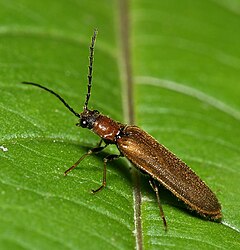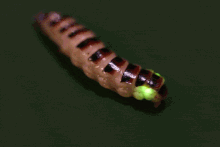Elateroidea
| Elateroidea Temporal range: Late Triassic–Recent PreꞒ Ꞓ O S D C P T J K Pg N | |
|---|---|
 | |
| Denticollis linearis, a click beetle (Elateridae) | |
| Scientific classification | |
| Domain: | Eukaryota |
| Kingdom: | Animalia |
| Phylum: | Arthropoda |
| Class: | Insecta |
| Order: | Coleoptera |
| Suborder: | Polyphaga |
| Infraorder: | Elateriformia |
| Superfamily: | Elateroidea Leach, 1815 |
| Families | |
| About 15-20, see text | |



The Elateroidea are a large superfamily of beetles. It contains the familiar click beetles, fireflies, and soldier beetles and their relatives. It consists of about 25,000 species.[1]
Description
Elateroidea is a morphologically diverse group, including hard-bodied beetles with 5 abdominal ventrites, soft-bodied beetles with 7-8 ventrites connected with membranes (formerly known as cantharoids), and beetles with intermediate forms.[2] They have a range of sizes and colours, but in terms of shape, they are usually narrow and parallel-sided as adults.[3]
Many of the sclerotised elateroids (Cerophytidae, Eucnemidae, Throscidae, Elateridae) have a clicking mechanism.[4] This is a peg on the prothorax which fits into a cavity in the mesothorax. When a click beetle bends its body, the peg snaps into the cavity, causing the beetle's body to straighten so suddenly that it jumps into the air.[5]
Most beetles capable of bioluminescence are in the Elateroidea, in the families Lampyridae (~2000 species), Phengodidae (~200 species), Rhagophthalmidae (100 species) and Elateridae (>100 species).[4]
Females in several lineages, including Lycidae, Lampyridae, Phengogidae and Rhagophthalmidae, do not pupate and remain in a larval form. This trait is estimated to have evolved independently at least three times within the superfamily.[6]
Some Elateroidea, including species of Cantharidae[7] and Lycidae,[8] have bright aposematic colours to signal to predators that they are poisonous and so should not be eaten.
Families
The validity and relationships of some families, such as Podabrocephalidae are not fully resolved. The family Rhinorhipidae has recently been removed to its own superfamily, with evidence that it is a basal taxon within Elateriformia dating to an Upper Triassic/Lower Jurassic split from other extant beetle lineages.[9]
- Artematopodidae Lacordaire, 1857 – soft-bodied plant beetles (= Eurypogonidae)
- Brachypsectridae Leconte & Horn, 1883 – Texas beetles
- Cantharidae Imhoff, 1856 – soldier beetles
- Cerophytidae Latreille, 1834 – rare click beetles
- Elateridae Leach, 1815 – click beetles (including Ampedidae, Balgidae, Dicronychidae, Drilidae, Lissomidae, Plastoceridae, Prosternidae, Protelateridae, Pyrophoridae, Synaptidae)
- Eucnemidae Eschscholtz, 1829 – false click beetles (including Anischiidae and Perothopidae)
- Iberobaeniidae Bocak et al., 2016
- Jurasaidae Rosa, Costa, Klamp & Kundrata, 2020
- Lycidae – net-winged beetles
- Omethidae LeConte, 1861 – false firefly beetles (including Telegeusidae)
- Throscidae Laporte, 1840 – false metallic wood-boring beetles (= Trixagidae)
- †Mysteriomorphidae Alekseev and Ellenberger, 2019 (Cretaceous)
- Lampyroid clade
- †Cretophengodidae Li, Kundrata, Tihelka & Cai, 2021 (Cretaceous)
- Lampyridae Latreille, 1817 – firefly beetles
- Phengodidae LeConte 1861 – glowworm beetles (including Cydistinae[1])
- Rhagophthalmidae Olivier, 1907 (sometimes in Phengodidae, might belong in Lampyridae)
- Sinopyrophoridae Bi & Li, 2019[4][10]
- Incertae sedis:
- †Anoeuma Li, Kundrata & Cai, 2022 (Cretaceous)
Phylogeny
Some morphological and molecular phylogenetic analyses find that Byrrhoidea is either a monophyletic or paraphyletic group closely related to Elateroidea.[11]
Based on Kusy et al. 2018[12] and 2020[4]
| Elateroidea | |
References
- ^ a b Kundrata, Robin; Blank, Stephan M; Prosvirov, Alexander S; Sormova, Eliska; Gimmel, Matthew L; Vondráček, Dominik; Kramp, Katja (2019-10-19). "One less mystery in Coleoptera systematics: the position of Cydistinae (Elateriformia incertae sedis) resolved by multigene phylogenetic analysis". Zoological Journal of the Linnean Society. 20 (4): 1259–1277. doi:10.1093/zoolinnean/zlz104. ISSN 0024-4082.
- ^ Li, Yan-Da; Kundrata, Robin; Packova, Gabriela; Huang, Di-Ying; Cai, Chen-Yang (2021-11-09). "An unusual elateroid lineage from mid-Cretaceous Burmese amber (Coleoptera: Elateroidea)". Scientific Reports. 11 (1): 21985. Bibcode:2021NatSR..1121985L. doi:10.1038/s41598-021-01398-w. ISSN 2045-2322. PMC 8578672. PMID 34753998. S2CID 243940384.
- ^ "Superfamily Elateroidea - Click Beetle, Lycid Beetles and Soldier Beetles". www.brisbaneinsects.com. Retrieved 2022-09-30.
- ^ a b c d Kusy, Dominik; He, Jin‐Wu; Bybee, Seth M.; Motyka, Michal; Bi, Wen‐Xuan; Podsiadlowski, Lars; Li, Xue‐Yan; Bocak, Ladislav (2020-08-25). "Phylogenomic relationships of bioluminescent elateroids define the 'lampyroid' clade with clicking Sinopyrophoridae as its earliest member". Systematic Entomology. 46. Wiley: 111–123. doi:10.1111/syen.12451. ISSN 0307-6970.
- ^ "Elateridae (click beetles)". www.ento.csiro.au. Retrieved 2022-09-30.
- ^ Mcmahon, Dino P.; Hayward, Alexander (2016). "Why grow up? A perspective on insect strategies to avoid metamorphosis: Insect strategies to avoid metamorphosis". Ecological Entomology. 41 (5): 505–515. doi:10.1111/een.12313. S2CID 86908583.
- ^ "Family Cantharidae - Soldier Beetles". bugguide.net. Retrieved 2022-09-30.
- ^ "Family Lycidae - Net-winged Beetles". bugguide.net. Retrieved 2022-09-30.
- ^ Kusy, Dominik; Motyka, Michal; Andujar, Carmelo; Bocek, Matej; Masek, Michal; Sklenarova, Katerina; Kokas, Filip; Bocakova, Milada; Vogler, Alfried P.; Bocak, Ladislav (2018-05-02). "Genome sequencing of Rhinorhipus Lawrence exposes an early branch of the Coleoptera". Frontiers in Zoology. 15 (1): 21. doi:10.1186/s12983-018-0262-0. ISSN 1742-9994. PMC 5930637. PMID 29743928.
- ^ Bi, Wen-Xuan; He, Jin-Wu; Chen, Chang-Chin; Kundrata, Robin; Li, Xue-Yan (2019-07-17). "Sinopyrophorinae, a new subfamily of Elateridae (Coleoptera, Elateroidea) with the first record of a luminous click beetle in Asia and evidence for multiple origins of bioluminescence in Elateridae". ZooKeys (864). Pensoft Publishers: 79–97. doi:10.3897/zookeys.864.26689. ISSN 1313-2970. PMC 6656784. PMID 31363346.
- ^ Beutel, R. G. (1995). "Phylogenetic analysis of Elateriformia (Coleoptera: Polyphaga) based on larval characters". Journal of Zoological Systematics and Evolutionary Research. 33 (3–4): 145–171. doi:10.1111/j.1439-0469.1995.tb00969.x. ISSN 1439-0469.
- ^ Kusy, Dominik; Motyka, Michal; Bocek, Matej; Vogler, Alfried P.; Bocak, Ladislav (2018-11-20). "Genome sequences identify three families of Coleoptera as morphologically derived click beetles (Elateridae)". Scientific Reports. 8 (1). Springer Science and Business Media LLC: 17084. Bibcode:2018NatSR...817084K. doi:10.1038/s41598-018-35328-0. ISSN 2045-2322. PMC 6244081. PMID 30459416.
External links

- Tree of Life - Elateroidea
- v
- t
- e
- Kingdom: Animalia
- Phylum: Arthropoda
- Class: Insecta
- Subclass: Pterygota
- Infraclass: Neoptera
- Superorder: Holometabola
Suborder Archostemata | |
|---|---|
|
Suborder Adephaga | |||
|---|---|---|---|
| |||
Suborder Myxophaga | |
|---|---|
|
Suborder Polyphaga | |||||||||||||||||||||||||||||||||||||||||||||||||
|---|---|---|---|---|---|---|---|---|---|---|---|---|---|---|---|---|---|---|---|---|---|---|---|---|---|---|---|---|---|---|---|---|---|---|---|---|---|---|---|---|---|---|---|---|---|---|---|---|---|
| |||||||||||||||||||||||||||||||||||||||||||||||||











